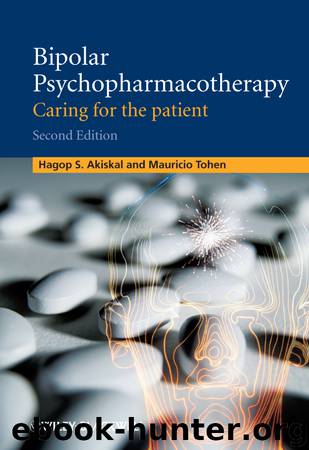Bipolar Psychopharmacotherapy by Akiskal Hagop S. Tohen Mauricio & Mauricio Tohen

Author:Akiskal, Hagop S., Tohen, Mauricio & Mauricio Tohen
Language: eng
Format: epub
Publisher: John Wiley & Sons
Published: 2011-03-14T16:00:00+00:00
13.3 HUMAN PHARMACOKINETICS
Asenapine sublingual is absorbed within seconds through the oral mucosa, its bioavailability is much higher when administered sublingually (that is, 35%) when compared to the swallowed tablet (that is, less than 2%) as a result of extensive first-pass metabolism. Buccal administration leads to approximately 20% greater bioavailability than sublingual administration; supralingual administration results in similar exposure to the sublingual route.
The effect of drinking water following sublingual administration of a single dose of asenapine (10 mg) was evaluated at 2, 5, 10, and 30 minutes after dosing in 15 healthy male subjects. The exposure of asenapine 10 minutes after dosing was equivalent to that when water was administered 30 minutes after dosing. As a result, there are no restrictions for food or drink after 10 minutes. A 19% reduction in bioavailability was noted following water administration at 2 minutes and a 10% reduction noted when water was administered at 5 minutes. In the phase 3 clinical trials, patients were instructed to wait 10 minutes before eating/drinking. Concomitant smoking exhibited no significant effect on the absorption of asenapine. It is unknown however if cigarette smoking affects overall asenapine bioavailability via its effect on inducing phase 1 metabolism (for example, CYP1A2).
Asenapine is rapidly absorbed, has a large volume of distribution (approximately 20–25 l/kg) and is highly bound to circulating proteins (for example, albumin and α-1- acid glycoprotein). Asenapine is noted to have a maximal plasma concentration of 0.5–1.5 hours after oral administration and a biphasic elimination half-life of 4–6 and 24 hours (Bishara and Taylor, 2009). N -Glucoronide-asenapine and N -desmethylasenapine are the two primary human metabolites of asenapine; they are not known to possess clinically relevant pharmacodynamic effects (Tarazi and Shahid, 2009).
Steady-state concentrations of asenapine are reached within three days of BID dosing. Asenapine is a substrate for CYP1A2, UGT1A4 and to a lesser extent CYP3A4 and CYP2D6. Asenapine is a weak inhibitor of CYP2D6 and does not induce CYP1A2 or CYP3A4 (Bishara and Taylor, 2009; Choi et al., 2010). The potential effects of concomitant medications on asenapine bioavailability were evaluated in healthy volunteers administered a single 5 mg dose of asenapine. Fluvoxamine, a CYP1A2 inhibitor, when administered at low dose (that is, 25 mg BID for eight days), increased asenapine maximum concentration (Cmax) by 13% and increased area under the curve (AUC) by 29%. Paroxetine 20 mg daily for nine days reduced Cmax 13% and AUC 9%; imipramine as a 75 mg single dose increased Cmax 17% and AUC 10%; cimetidine 800 mg BID for eight days reduced Cmax 13% and increased AUC 1%; carbamazepine 400 mg BID for 15 days decreased Cmax and AUC 16% respectively; while valproate 500 mg BID for nine days increased Cmax 2% and decreased AUC 1%. It was concluded that no asenapine dose adjustments will be required when co-administering with these agents.
Download
This site does not store any files on its server. We only index and link to content provided by other sites. Please contact the content providers to delete copyright contents if any and email us, we'll remove relevant links or contents immediately.
Should I Stay or Should I Go? by Ramani Durvasula(6785)
Why We Sleep: Unlocking the Power of Sleep and Dreams by Matthew Walker(5642)
Fear by Osho(4085)
Flow by Mihaly Csikszentmihalyi(4053)
Rising Strong by Brene Brown(3783)
Why We Sleep by Matthew Walker(3773)
Too Much and Not the Mood by Durga Chew-Bose(3696)
How to Change Your Mind by Michael Pollan(3679)
The Hacking of the American Mind by Robert H. Lustig(3580)
Lost Connections by Johann Hari(3455)
He's Just Not That Into You by Greg Behrendt & Liz Tuccillo(3303)
Evolve Your Brain by Joe Dispenza(3051)
What If This Were Enough? by Heather Havrilesky(2945)
Resisting Happiness by Matthew Kelly(2888)
Crazy Is My Superpower by A.J. Mendez Brooks(2861)
The Courage to Be Disliked by Ichiro Kishimi & Fumitake Koga(2798)
The Book of Human Emotions by Tiffany Watt Smith(2771)
Descartes' Error by Antonio Damasio(2732)
In Cold Blood by Truman Capote(2685)
